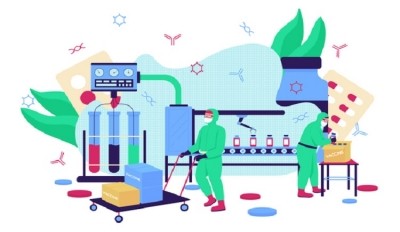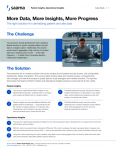bio international 2022
Can the industry elevate the success rate of cancer trials?

An estimated 90% of clinical trials centered on cancers fail, sending those potential oncological treatments either to the drawing board or the scrap heap. Each unsuccessful trial means billions lost in R&D investment and, potentially, countless lives.
During this year’s BIO International Convention (taking place June 13-16 in San Diego), a group of industry professionals will share with attendees reasons why it doesn’t have to be that way. Matthew Clark, board member and advisor with CerFlux, is one of the panelists speaking during Cancer Trials Don’t Have to Fail 90% of the Time. Seriously, scheduled at 11 am PDT on Wednesday, June 15; Outsourcing-Pharma recently connected with Clark to learn about the session, and how cancer-centered trials might be able to improve their prognosis.
OSP: Could you please share your thoughts about the high failure rate of cancer trials, and how that proportion has changed over the years?
MC: One of the clearest presentations of this data from 2004 through 2015 is a study by Wong and colleagues in 2019 that indicated a 3.4% probability of success for oncology development efforts. Their research also revealed that over the last twenty years there has been little change in the probability of success of clinical trials as they vacillated around 5%.
The most recent results published by BIO last year showed a roughly 5.4% likelihood of success from preclinical to FDA approval for cancer treatments. This reveals that in terms of outcomes there is little improvement over the last 20 years.
OSP: In a nutshell, what are some of the reasons (big and small) for that high rate?
MC: There are numerous reasons for this high failure rate. I’ll highlight only a few that require our attention. Perhaps the biggest reason is that cancer involves many variables involving heterogeneous populations and disease presentations. This conclusion is further evident from the consistently low failure rate of clinical trials prior to approval (90-98% failure) over more than a decade and the low probability of successful therapy (<25%) from FDA-approved therapeutics. This suggests that we consistently choose a target for therapy that cannot be demonstrated via traditional clinical trials.
Another reason related to multivariate factors in clinical trials for cancer pharmaceutical developments includes challenges with inclusion criteria for clinical trial participants. Simply put, the clear suggestion is that we are not testing the right products, focused on the right factors or outcome variables for clinical benefit, in the right populations or models, at the right time prior to going to clinical trial. We have to remember that clinical trials should be demonstrations of clinical utility rather than exploratory in nature or purpose.
OSP: What kinds of solutions might pharma companies and their research partners have tackled in the past to try and bring that number down?
MC: Biomarkers are perhaps the focus of the greatest push over the last nearly 20 years in the pharmaceutical industry. Most pointedly, there is a focus on “omics” to identify appropriate biomarkers. These approaches include proteomics, genomics, and metabolomics, to name a few, and are developing towards “multi-omics.”
Since the early 2000s, the argument has been that they can make a big difference, particularly when combined with existing techniques. The method is effective for exploratory research but has not produced the consistent results needed for the traditional groups-based designs generally used in clinical trials.
Similarly, cell-line-derived xenografts, patient-derived xenografts, and genetically modified animal models have generated lots of excitement because they attempt to mimic complex microenvironments or biological processes leading to or promoting cancer. These methods are expensive, time-consuming, and ultimately serve as a model that may not generalize back to the human disease state.
Unfortunately, the success of all of these approaches is less than clear as indicated by the consistently low “probability of success” or “likelihood of approval” at around 5% for more than 20 years. These efforts may have potential in the preclinical and exploratory arena, but to date, they have had little value in clinically relevant, therapeutic pharmaceutical development in the aggregate.
OSP: How can personalized medicine help elevate oncological drug development?
MC: A primary goal of personalized medicine is to tackle the heterogeneity of cancer directly. At the core, cancer is personalized, so the treatment of cancer must likewise be personalized.
However, the strategies for clinical success generally require group-based designs. This means the goal is to use individual responses to both the disease and possible therapeutics to identify the factors or biological processes at the right time allowing for better targets for therapeutic development that are not only effective but also have fewer side effects.
Through personalized medicine, we can take a more refined and nuanced approach to the treatment of different cancers that manifest in categorical and specific ways that treat the factors evident for a subgroup of those with the disease. Focused development will lead to more focused and more effective drug indications.
Done effectively, we believe that personalized medicine can further reduce the costs and time of drug development by elucidating what factors matter when in the progression of the disease. Therefore, personalized medicine can reduce the noise that historically plagued the development of drugs for cancer ultimately upending the vast majority of clinical trials.
We believe that with personalized medicine we can address the variability inherent in cancer by better identifying and aligning the idiosyncratic and temporal aspects of cancer with the concomitant treatments that are required; essentially, synchronizing the variability in cancer with the array of therapeutic formulations like two overlapping sine curves instead of interference from being out of phase.
Another outcome of personalized medicine is that it can help reduce hesitancy to participate in clinical trials through better target selection concurrently with off-target identification. It also will improve inclusion criteria, endpoint selection for trials, clinical trial planning, and decrease the cycle time for trials to enroll and complete. Each of these is a challenge to the development of cancer therapeutics that personalized medicine can improve.
OSP: How can companies like yours help drug development pros harness PM to put their cancer treatment candidates on a more favorable path?
MC: The hallmark of the CerFlux platform is providing a preview of clinical response well in advance of clinical development through ex vivo screening and analytics of drugs, or combinations of drugs, directly against actual tumor biopsy. Such previews could vastly improve productivity and returns by redirecting investment in more productive assets early – and also improve patient outcomes.
Screening directly against tumor biopsies allows us to evaluate and better appreciate the heterogeneity and complexity of cancer in relevant ways that should be predictive of clinical outcomes. For instance, directly analyzing patient tumor biopsy avoids distortion of tissue composition and microarchitecture resulting from dissociation or expansion. Further, since core biopsies are standard of care for many solid tumors, such evaluation would add minimal burden on patients and clinical care teams.
Finally, assessment of standard of care biopsies would also mitigate racial and ethnic biases. This would allow pharmaceutical companies to better target their limited resources on drugs that are likely to have a higher probability of success on a broader population while further reducing the probability of negative side effects. Of course, our approach will not be a panacea, but we believe that it will be a notable improvement over the current approach that is clearly not working. Over time, iterative and incremental improvements through our process will help people find ways to live productive lives with cancer.
OSP: Do you have anything to add?
MC: Thank you for the opportunity to share our perspective and how we are trying to motivate change in this important area. The more we transparently challenge ourselves to be better, the greater the opportunity to partner for solutions that make a difference for those living with cancer.
The BIO International Convention is scheduled June 13-16 at the San Diego Convention Center. Visit the show website for more information or to register.




















